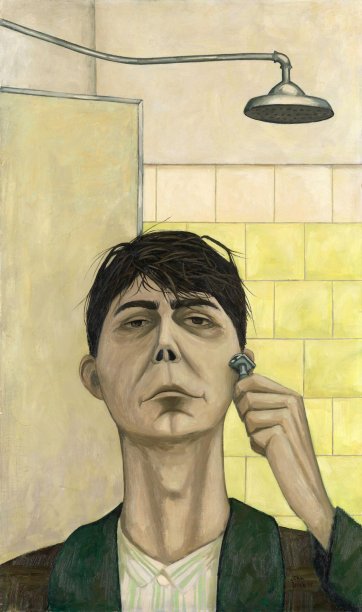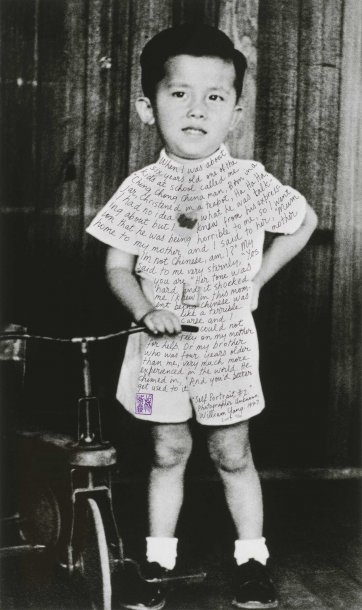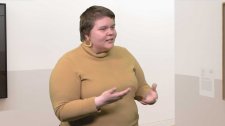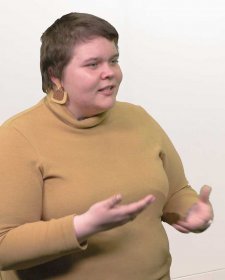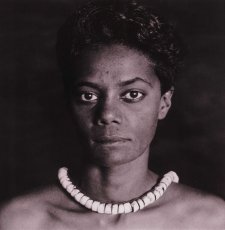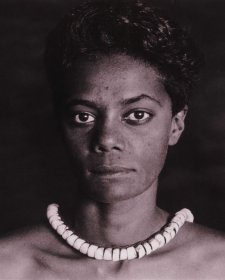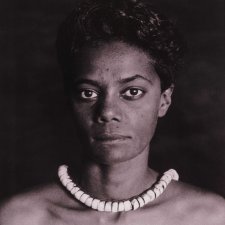- So the two portraits that I've chosen to compare and contrast and to bring together a self portrait from the National Gallery of Victoria's collection by John Brack in 1955. And from our collection, a recent edition, I've got William Yang, self portrait number two. William Yang, I'll talk about him first. So he is done it in a sequential but also not sequential manner. So we've got self-portrait number two here. It's always about checking in with him and his identity, which as we know was a big part of him as a photographer. He was a really big name in the seventies and eighties in Sydney. He was a gay man and he was really into the subcultures specifically of the, the Mardi Gra which was beginning at the time and those inner circles. He photographed his friends and families and always had his finger on the pulse. Once it hit the eighties, he sort of turned and started considering himself a lot more and his role along the way in terms of his own sexual identity and his cultural heritage. So here in this portrait, we can see he's talking about him learning that he was Chinese. That as a little boy, he hadn't really thought about it. And somebody said something quite horrible to him when he was at school, just written onto the portrait and he went home and asked his mom, "Mom, I'm not Chinese am I?" And his mom had to go, "Yes you are." And his brother chimes in as you can read through, "And you better get used to it."
- Oh.
- And so him coming to terms with his Chinese heritage was this, quite a large thing for him. And we see himself portrait, we see another self-portrait later on where he's coming out as a Chinese man, which I think is funny because he said that he never came out as a gay man. It just came out. He was swept up in the events of the time.
- Yeah.
- So to come out as a Chinese person, but not as a gay man. And it feels sort of blasphemous for me to talk about William Yang, because he speaks so beautifully about himself and all throughout his career he has engaged in performances when he speaks almost to a slide show of his works, behind him and he's done a few here at the portrait galleries where I do recommend, anybody hasn't seen them, you should.
- Yes.
- Definitely have a look to hear himself talk about his life is just fascinating, is just beautiful, I suppose. And so comparing it back to the John Brack work, this is another portrait of an artist checking in with themselves, but at a young age. So this is in 1955 when John Brack was really picking up and getting more and more commissions and exhibitions in the art scene, it was a busy time for Melbourne in 1955 with the 1956 Olympics about to happen. And there were lots of changes in the city. These big changes weren't necessarily replicated in what John Brack was painting at the time, but he's been so well known for his depictions of an Austria drab Melbourne.
- Yeah.
- People look at his works and think, is it sentimental, satire or sympathetic to Melbourne? And no one can really agree on what comes forward. Looking at this portrait here, is it favourable to him? Does he present himself in a good light or in a very critical light? I think he is analysing himself in a little way. If you look at his eyes, it's certainly not very flattering, but the slight turn of his mouth, I think really makes for, an altogether optimistic portrait perhaps, his shaving himself to get ready for a long career of being a successful artist.
- Yeah.
- But this painting of a self portrait of John Brack, he did about, in the end, about 10% of his final output was portraits. We had an exhibition at the portrait gallery in 2007, portraits by John Brack, it was actually our last exhibition in the old parliament house before we moved to our new building. But many people who have been the recipient of a John Brack portrait, haven't always felt so blessed by the commission famously galerist and purvist from, of the Australian galleries fame. There was a portrait of her commission by her husband, Tam. We've got a portrait of him in our collection as well. They were made around the same time. But apparently upon receiving the portrait from Brack, she burst into tears.
- Oh no.
- And then when it was ever on display in their family home it was always a source of great tension and anxiety for her and Stewart Purvis, who's now the director of Australian galleries tells the story of coming home one day when he was quite young, finding a 44 gallon drum on fire and her mother, and so, his mother picking up the portrait and burning it. So that portrait is now unfortunately destroyed.
- Oh no.
- Yes. And that went on to, in some ways bite the Australian galleries in the bum a little bit because later on when George Mora, William, sorry John Brack's galerist passed away and he was looking for a new representation. He did not go to Australian galleries because he didn't wanna be represented by a couple who burned his portrait.
- That's fair enough.
- It is fair enough, indeed.
